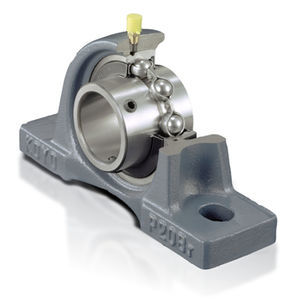
- Components - Spare Parts
- Landing and Braking
- Cylindrical roller bearing
- KOYO BEARINGS VIERZON MAROMME (GROUPE JTEKT)
Cylindrical roller bearing radialsingle-rowdouble-row
Add to favorites
Compare this product
Characteristics
- Rolling element
- cylindrical roller
- Configuration
- radial, single-row, double-row, four-row
- Material
- carbon steel
- Other characteristics
- precision, high-speed
Description
Features include thrust collars, parallel or tapered bore and lubrication holes and grooves. This type of bearings feature high radial load capacity as the rollers and raceway are in linear contact. Our cylindrical bearings are equally suitable for heavy radial and impact loading.
Cylindrical roller bearings are characterized by high radial-, and moderate thrust-load capacities. They contain cylindrically-shaped roller, which are nevertheless not true cylinders. Instead, they are crowned or end-relieved to reduce stress concentrations. This particular geometry results in low friction and allows high-speed applications. Cylindrical roller bearings are commonly available in precision grades such as RBEC-5, a classification from the Roller Bearing Engineers Committee (RBEC). RBEC ratings describe the accuracy and tolerance range of different types of bearings. As a rule, the higher the RBEC number, the tighter the bearing tolerances. Typically, cylindrical roller bearings are lubricated with oil, which also serves as a coolant.
Most cylindrical roller bearings are made of alloy or low-carbon steels. Some applications require the use of case-hardened or through-hardened, high-carbon, bearing-quality steel. High-carbon grades of steel do not require carburizing and can be case-hardened by induction heating or through-hardened by conventional heating methods. When low-carbon, carburized grades of steel are used, carbon is introduced after the cylindrical roller bearings are machined to a depth sufficient to produce a hardened case that can sustain bearing loads. The addition of carbon and alloys ensures the proper combination of a hard
Catalogs
No catalogs are available for this product.
See all of KOYO BEARINGS VIERZON MAROMME (GROUPE JTEKT)‘s catalogsOther KOYO BEARINGS VIERZON MAROMME (GROUPE JTEKT) products
PRODUCTS
Related Searches
- JTEKT bearing
- Ball bearing bearing
- JTEKT airliner bearing
- Steel bearing
- JTEKT roller bearing
- JTEKT radial bearing
- Precision bearing
- Double-row bearing
- Single-row bearing
- Angular-contact bearing
- Pre-lubricated bearing
- Heavy load bearing
- Deep groove bearing
- Cage assembly bearing
- Axial bearing
- Cylindrical roller bearing
- Self-aligning bearing
- Sealed bearing
- High-speed bearing
- Stainless steel bearing
*Prices are pre-tax. They exclude delivery charges and customs duties and do not include additional charges for installation or activation options. Prices are indicative only and may vary by country, with changes to the cost of raw materials and exchange rates.











